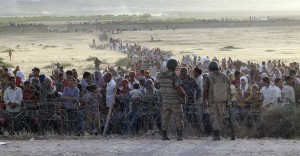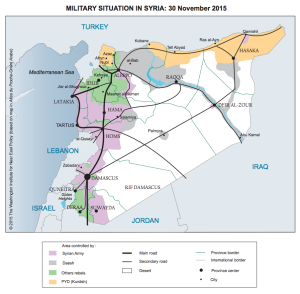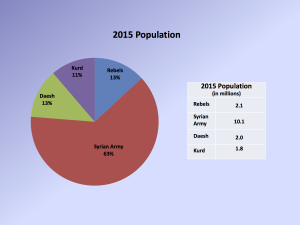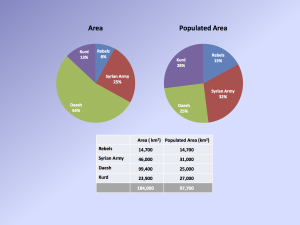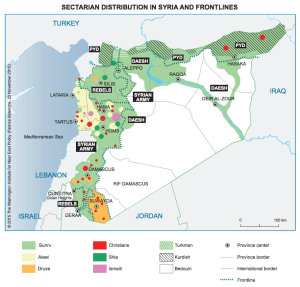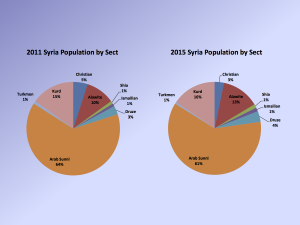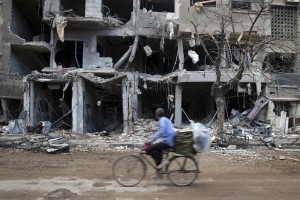Since the attacks in Paris last month, discussions about Syria have focused exclusively on the Islamic State of Iraq and al-Sham (ISIS) and the growing refugee crisis. In an effort to counter ISIS and limit the flow of refugees, Europe and the United States have been sending Syrians all the wrong messages. The Syria Justice and Accountability Centre (SJAC) has compiled and summarized just a few of the most problematic messages over the last three weeks:
- National Security Takes Priority Over Mass Human Suffering
In the wake of a coordinated and far-reaching attack like the one in Paris, it is understandable that national security is a top priority for Europe. It is the role of the state to protect its citizens, and European governments have been acting accordingly. But the issue of refugees has become so much entangled in the national security debate that the two disparate topics have become blurred in the media and political rhetoric. Since the start of the conflict, Syrian President Bashar al-Assad has justified his brutality by claiming that those who oppose him are terrorists and should be treated as threats. Instead of viewing the refugee crisis as a humanitarian problem and human rights failure, the current international debate has reinforced Assad’s justifications by painting refugees as a national security problem, ignoring the mass human suffering Syrians have experienced after four years of war.
- The Need to Fight ISIS Excuses Assad
In recent weeks, the world has united against ISIS. The UK, which previously voted against military involvement, decided last week to expand airstrikes into Syria. Germany has said it will send 1,200 ground troops, and France has been aggressively bombing Syria since the Paris attacks. Russia, a Syrian government ally, has welcomed these efforts, which have by and large deflected criticism from Assad. In addition, the growing consensus among the anti-ISIS coalition is that Assad will need to be part of negotiations and the future transition in Syria. As a result, pressure on Assad has waned. For Syrians, it seems as though the West is willing to now turn a blind eye to Assad’s crimes in order to stand united against ISIS, a no doubt brutal extremist group, but not the original cause of the Syrian conflict.
- Turkey’s European Union Accession is about Keeping Refugees Out, Not Democracy
Over the last several years, Turkey has been in a downward spiral with regards to democracy and free speech. Journalists and social media activists are being targeted at an unprecedented rate, anti-Kurdish violence and rhetoric is increasing, and many observers criticized the political manipulation of the latest round of elections. Five years ago, when Europe stalled accession negotiations, Turkey was in a much better position than it is now to accede; yet, despite Turkey’s democratic downturn, the EU has recently agreed to relaunch accession talks if Turkey takes measures to prevent refugees from migrating to Europe. In reaching this decision, the EU has apparently decided to ignore its first criteria for accession talks — guarantees of “democracy, the rule of law, human rights and respect for and protection of minorities.” The message is that the EU is willing to sacrifice its democratic values for guarantees that refugees will be kept out of Europe, thus discrediting many of the EU’s founding principles.
- Syrians Do Not Have a Voice in Their Own Future
Many of the conversations about Syria’s future transition appear to be happening behind closed doors between high-level, non-Syrian officials. Recently, Russian President Vladimir Putin said that he had a fruitful discussion about the parameters of a Syrian transition with US President Barack Obama on the sidelines of the climate change talks in France. Even in the recent Vienna talks on Syria, only the foreign ministers of the International Syria Support Group (including Russia, the US, several EU countries, Iran, Turkey, and Saudi Arabia) attended. Syrian representatives — either from the government or the opposition — were notably absent. Despite the oft repeated mantra that Syrians must be the ones to decide their future, the broad trajectory of a peace plan and transition are being negotiated without Syrian participation, and many Syrians on the ground are confused and uninformed about the process.
- Political Bargaining Does Not Account for Human Rights
Talks planned for Vienna after the New Year will eventually include Syrian participation, as the Syrian government and a delegation of the Syrian opposition are expected to begin negotiating an end to the four year conflict. In addition to the Syrian National Coalition, the delegation will include leaders of the armed opposition. Already, Saudi Arabia has invited potential members of the delegation to a meeting in Riyadh to prepare. Jordan has been tasked with determining which of the groups and relevant factions should be excluded from Vienna due to ties with terrorism, but a satisfactory human rights record is not a factor for determining eligibility. Representatives from Jeish al-Islam and Ahrar al-Sham will likely participate in both the Saudi prep meeting and the Vienna negotiations. While it is true that the buy-in of fighters is needed to assure the success of any future deal, many of these armed groups are responsible for gross human rights violations. Since the talks will involve extensive political bargaining, it would be a shame for the leaders of Jeish al-Islam to have a role in Syria’s transitional government simply because they had a seat at the table. Which brings us to the last point of concern…
- Arms, Not Non-Violence Will Get You a Seat at the Table
Billions of Euros, British Pounds, and US Dollars have been spent to build the capacity of Syrian civil society on the international human rights framework, nonviolent resistance, and democratic transitions. Yet Syrian activists who have dedicated their lives, often as volunteers, to these ideals have not been invited to Riyadh and will likely not have a seat at the table in Vienna. Although a few Syrian “national figures” will attend the meeting in Riyadh, these individuals are not considered to be credible and impartial representatives of the larger civil society. To the knowledge of SJAC, not a single civil society organization will participate. Instead, as previously mentioned, leaders of armed groups, often with tenuous human rights records, will be in attendance. This sends mixed messages to Syrians about the actual importance of the international human rights framework and nonviolence when it comes to power and politics.
These are likely not the messages that Europe and the United States want to be projecting. Yet, many Syrians are already pointing to the abovementioned issues and highlighting the paradox of the statements made by the United States and Europe. There is a need for clarity, particularly in regards to the role of justice as well as the values and ideals that form the basis for Syria’s transition. Because the negotiations and political bargaining that happen today will affect the stability and democratic foundations of Syria tomorrow.
For more information and to provide feedback, please email SJAC at info@syriaaccountability.org.
